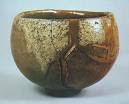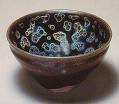:::::::::::::::::::::::::::::::::::::::::::::::::::::::::::::::::::::::::::::::::::::::::::::::::::::
Daruma Pilgrims Gallery
:::::::::::::::::::::::::::::::::::::::::::::::::::::::::::::::::::::::::::::::::::::::::::::::::::::
Raku Kichizaemon XV
樂 吉左衛門(らく きちざえもん)

Born 1949, he is the current Raku tea bowl master.
He lives in Kyoto to the west of the Imperial Palace. The studio where he makes and fires the tea bowls called "Raku-yaki ochawan ya" (Raku-ware workshop) is behind his residence. Raku XV Kichizaemon's tea bowls, like his predecessor's, embodies his own style of shapes and glazes. His work incorporates multipe glazes on bowls that vary greatly in shape and glaze decoration.

Click for more photos.
..................................................
A Brief History of Raku Tea Bowls
Len Eichler, Art Teacher
Raku tea bowls originated in Japan in the late 16th Century. These small, austere and often irregular-shaped bowls were made for the purpose of drinking a powdered green tea during the Zen Buddhist tea ceremony. The tea ceremony was formulated during that time by the great Tea Master, Sen no Rikyu (1522-1591). Rikyu was the Tea Master for the great warlord, Toyotomi Hideyoshi (1536-1598). Rikyu designed the tea ceremony, "cha no yu" to promote the contemplation of the beauty of simplicity, "wabi". The term "wabi-cha" is used to describe Rikyu's tea ceremony. "Chado", the way of tea, refers to the ritualistic aspects of the tea ceremony, from the "chashitsu" (tea room) to the use of special utensils and formal etiquette that requires years of study by tea masters. (see History of Tea Ceremony)
Rikyu was an aesthete who appreciated art and poetry. When he saw the sculptures of a tile maker named Chojiro (?-1589) in Kyoto, Rikyu commissioned him to make bowls for the "wabi-cha". Chojiro did not use the wheel. He formed his bowls using a combination of pinching and carving. The bowls were generally symmetrical and had no special decoration. (see illus.1) The finished bowls were so austere, that one could say they were devoid of self expression.
Chojiro sublimated his own artistic impulse to produce bowls that embodied the ideal of "wabi". The warlord Hideyoshi was so pleased with the bowls, he used the term "raku 楽 ", which is usually translated to mean "the joy of leisure time"or "ease". The Raku-yaki website points to the word "Jurakudai", which was the name of a palace built by Hideyoshi, as the origin of the word "raku". After the death of Chojiro his young apprentice Jokei was given a gold seal with the "raku" ideograph by Hideyoshi in memory of Chojiro. Raku has been used as part of the family name from that time on.
Chojiro used two different clay bodies. Both contained a high percentage of sand or temper to help reduce thermal shock. One body was a red earthenware (high ochre content) and the other a stoneware body. The red earthenware bowls were glazed with a clear glaze and fired up to four at a time in a special kiln designed for low firing. The bowls were placed in a saggar (protective ceramic canister) in the kiln. The saggar provided protection from the burning charcoal and helped reduce uneven heating. A lid covered the saggar.
When the glaze reached the melting point (recognized by color of the fire about 1,000 C) the lid, which had to holes in it, was removed using tongs. The bowls were removed while red hot from the saggar in the kiln and place into another saggar outside of the kiln to cool quickly. Raku Donyu III (1599-1656) made red tea bowls that are regarded as the brightest red ever achieved using this firing method.
The stoneware black bowls were coated with a glaze made from crushed black pebbles from the Kamo River in Kyoto. The iron and manganese content was suffient to produce an intense black but at a higher temperature, about 1,200 C. The black bowl bowls were fired one at a time in a special kiln without a roof that also contained a saggar, but this kiln was loaded with much more charcoal. A special bellows box operated by an assistant was used to pump large quanities of air into the kiln to burn the charcaol quicker and hotter.
The first matte finish black bowls made by Chojiro probably did not get fired as hot as the shiny lustrous black bowls by Raku Donyu III . As with the red raku bowls, the bowl was removed from the kiln when red hot and allowed to cool in a saggar at room temperature, not by dipping in water or by setting the ware in combustibles as is done in Western versions of Raku.
© Len Eichler
:::::::::::::::::::::::::::::::::::::::::::::::::::::::::::::::::::::::::::::::::::::::::::::::::::::

Raku Kichizaemon 楽吉左衛門 the 15th was the son of the 14th Raku master Kakunyu (1918–1980). He studied sculpture at the Tokyo University of Fine Arts, graduating in 1973. He became the 15th Raku master in 1981.
Traditional Japanese Raku was developed the 16th century by Chojiro for use in the Japanese tea ceremony. From Chojiro’s time, there has been a succession of true Raku masters, whose duty it is to carry on the tradition. According to the custom, this line of Raku masters are the only ones entitled to call their ware ‘Raku’, however other potters around the world practice the technique none-the-less.
Traditional Raku is hand formed, not wheel-thrown. The sides and feet are shaven or cut with a knife or spatula, resulting in a distinctly individual form. The pieces are bisque-fired, and glazed with a low temperature lead glaze. They are then quickly refired and removed from the kiln with tongs while glowing hot.
Legend has it that the name ‘Raku’, which means ‘enjoyment’ or ‘pleasure’ came from a stamp given to the second Raku master Jokei by Emperor Toyotomi Hideyoshi. Hideyoshi was a connoisseur of Raku wares and had the stamp made because Jokei used a clay called 'Juraku-zuchi', which was dug from the emperors Lustgarten 'Juraku-dai' 聚楽第 (じゅらくだい/じゅらくてい).
© Ceramics Today
:::::::::::::::::::::::::::::::::::::::::::::::::::::::::::::::::::::::::::::::::::::::::::::::::::::
。。。。。。。。。。。。。。楽

CLICK for more Kichizaemon photos !

CLICK for more general Raku Teabowls photos !
:::::::::::::::::::::::::::::::::::::::::::::::::::::::::::::::::::::::::::::::::::::::::::::::::::::
Tenmoku Chawan

CLICK for more types of Japanese tea bowls
Tenmoku Tea Bowls, REFERENCE
Tea Ceremony Saijiki 茶道の歳時記
Daruma Pilgrims in Japan
:::::::::::::::::::::::::::::::::::::::::::::::::::::::::::::::::::::::::::::::::::::::::::::::::::::






1 comment:
I can't imagine myself making and firing the bowls (probably end up firing my own fingers!), but I think I'd enjoy painting them. A possible hobby for retirement, who knows.
finger-painting
tea leaves onto a bowl
... winter evening
Ella Wagemakers
Post a Comment